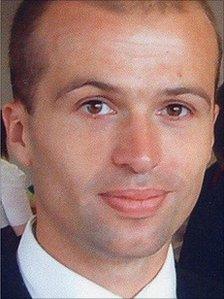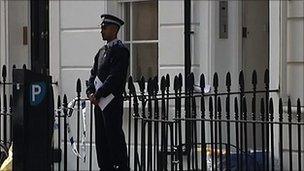MI6 death: Gareth Williams's family in 'dark arts' fear
- Published

Gareth Williams's body was found in a padlocked bag in a flat
An MI6 officer whose body was found in a holdall may have been killed by an agent "specialising in the dark arts of the secret services", a court heard.
Gareth Williams, 31, originally from Anglesey, was found in a padlocked bag at his London flat in August 2010.
Lawyer Anthony O'Toole told the pre-inquest hearing Mr Williams's family believed a third party was present at his death or later destroyed evidence.
The court also heard there was a mix-up with DNA found on Mr Williams's body.
Mr O'Toole told Westminster Coroner's Court: "The impression of the family is that the unknown third party was a member of some agency specialising in the dark arts of the secret services - or evidence has been removed post-mortem by experts in the dark arts."
He suggested evidence may have been removed from the top-floor flat in Alderney Street, Pimlico, because there was no DNA evidence, fingerprints or any sign of covert entry.
Mr O'Toole said Mr Williams "could have been actively deployed" as an agent up to five months before his death and added that the family want to know why the alarm was not raised when the MI6 officer had failed to turn up to work.
"In our submission, to properly explore the circumstances of the death, we need to establish the deceased's work," the lawyer said.
'Red herrings'
Post-mortem examinations on the body were ineffective and evidence was lost because the body was so decomposed when it was found, the lawyer said.
Earlier Coroner Fiona Wilcox heard from Metropolitan Police Det Ch Insp Jacqueline Sebire who said a DNA sample found on Mr Williams's hand was considered a "key line of inquiry".
But the sample later turned out to match a scientist who was working at the crime scene in 2010.

Police said a DNA sample found on Mr Williams was contaminated by a scientist at the scene
The Met has begun a review into how other forensic evidence in the case was handled.
Another "red herring" was a Mediterranean couple the police were seeking in connection with the death, the hearing was told.
Regarding the error by forensic teams, Dr Wilcox said: "It's been an ongoing problem for me, the late provision of evidence."
She also said that whether the code-breaker was able to lock himself in the bag would be "at the very heart" of the inquest.
Dr Wilcox said she would like a practical demonstration in court of how a person could get into a bag and lock it up from the inside.
The bag in which Mr Williams was found, a North Face holdall, was placed in his bath at the flat.
'Apology to family'
Police originally found it would have been impossible for him to have locked himself inside.
The inquest will hear from experts who agree that it "would have been very difficult, if not impossible" for him to lock the bag from the inside, the Met Police's lawyer Vincent Williams said.
He suggested the evidence would be sufficient and there may not be a need for a demonstration as to how Mr Williams might have locked himself in.
The remainder of the pre-inquest hearing was closed to the public.
Mr Williams was a mathematics prodigy who worked as a cipher and codes expert for GCHQ, the government listening station, and had been on secondment to MI6.
The inquest, which is expected to begin in April, will hear from Mr Williams's colleagues from MI6 and the GCHQ, toxicology experts, bag experts, as well as a statement from his sister.
It will also hear that the MI6 officer may have died after breathing too much carbon dioxide.
LGC, the laboratory involved in the DNA mix-up, said it was "sorry for any pain this error may have caused" to the deceased man's family.
- Published23 August 2011
- Published5 April 2011
- Published15 February 2011
- Published22 December 2010
- Published25 August 2010